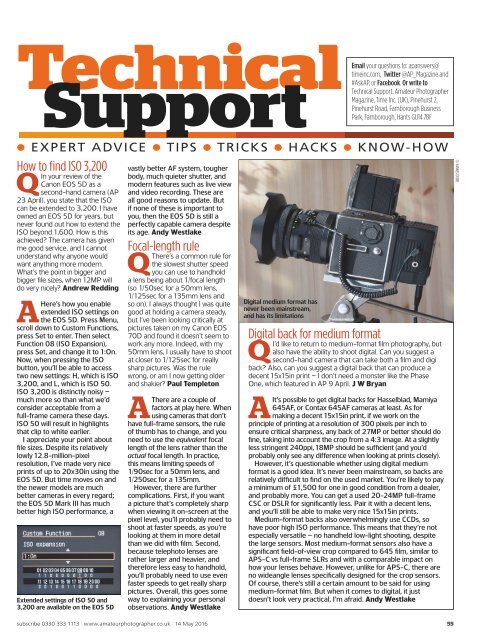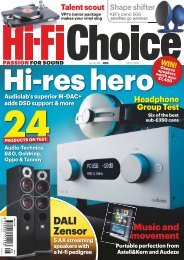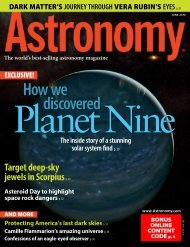Create successful ePaper yourself
Turn your PDF publications into a flip-book with our unique Google optimized e-Paper software.
Technical<br />
Support<br />
Email your questions to: apanswers@<br />
timeinc.com, Twitter @AP_Magazine and<br />
#AskAP, or Facebook. Or write to<br />
Technical Support, Amateur Photographer<br />
Magazine, Time Inc. (UK), Pinehurst 2,<br />
Pinehurst Road, Farnborough Business<br />
Park, Farnborough, Hants GU14 7BF<br />
l ExpErt advicE l tips l tricks l hacks l know-how<br />
How to find ISO 3,200<br />
QIn your review of the<br />
Canon EOS 5D as a<br />
second-hand camera (AP<br />
23 April), you state that the ISO<br />
can be extended to 3,200. I have<br />
owned an EOS 5D for years, but<br />
never found out how to extend the<br />
ISO beyond 1,600. How is this<br />
achieved? The camera has given<br />
me good service, and I cannot<br />
understand why anyone would<br />
want anything more modern.<br />
What’s the point in bigger and<br />
bigger file sizes, when 12MP will<br />
do very nicely? Andrew Redding<br />
AHere’s how you enable<br />
extended ISO settings on<br />
the EOS 5D. Press Menu,<br />
scroll down to Custom Functions,<br />
press Set to enter. Then select<br />
Function 08 (ISO Expansion),<br />
press Set, and change it to 1:On.<br />
Now, when pressing the ISO<br />
button, you’ll be able to access<br />
two new settings: H, which is ISO<br />
3,200, and L, which is ISO 50.<br />
ISO 3,200 is distinctly noisy –<br />
much more so than what we’d<br />
consider acceptable from a<br />
full-frame camera these days.<br />
ISO 50 will result in highlights<br />
that clip to white earlier.<br />
I appreciate your point about<br />
file sizes. Despite its relatively<br />
lowly 12.8-million-pixel<br />
resolution, I’ve made very nice<br />
prints of up to 20x30in using the<br />
EOS 5D. But time moves on and<br />
the newer models are much<br />
better cameras in every regard;<br />
the EOS 5D Mark III has much<br />
better high ISO performance, a<br />
Extended settings of ISO 50 and<br />
3,200 are available on the EOS 5D<br />
vastly better AF system, tougher<br />
body, much quieter shutter, and<br />
modern features such as live view<br />
and video recording. These are<br />
all good reasons to update. But<br />
if none of these is important to<br />
you, then the EOS 5D is still a<br />
perfectly capable camera despite<br />
its age. Andy Westlake<br />
Focal-length rule<br />
QThere’s a common rule for<br />
the slowest shutter speed<br />
you can use to handhold<br />
a lens being about 1/focal length<br />
(so 1/50sec for a 50mm lens,<br />
1/125sec for a 135mm lens and<br />
so on). I always thought I was quite<br />
good at holding a camera steady,<br />
but I’ve been looking critically at<br />
pictures taken on my Canon EOS<br />
70D and found it doesn’t seem to<br />
work any more. Indeed, with my<br />
50mm lens, I usually have to shoot<br />
at closer to 1/125sec for really<br />
sharp pictures. Was the rule<br />
wrong, or am I now getting older<br />
and shakier? Paul Templeton<br />
AThere are a couple of<br />
factors at play here. When<br />
using cameras that don’t<br />
have full-frame sensors, the rule<br />
of thumb has to change, and you<br />
need to use the equivalent focal<br />
length of the lens rather than the<br />
actual focal length. In practice,<br />
this means limiting speeds of<br />
1/90sec for a 50mm lens, and<br />
1/250sec for a 135mm.<br />
However, there are further<br />
complications. First, if you want<br />
a picture that’s completely sharp<br />
when viewing it on-screen at the<br />
pixel level, you’ll probably need to<br />
shoot at faster speeds, as you’re<br />
looking at them in more detail<br />
than we did with film. Second,<br />
because telephoto lenses are<br />
rather larger and heavier, and<br />
therefore less easy to handhold,<br />
you’ll probably need to use even<br />
faster speeds to get really sharp<br />
pictures. Overall, this goes some<br />
way to explaining your personal<br />
observations. Andy Westlake<br />
Digital medium format has<br />
never been mainstream,<br />
and has its limitations<br />
Digital back for medium format<br />
QI’d like to return to medium-format film photography, but<br />
also have the ability to shoot digital. Can you suggest a<br />
second-hand camera that can take both a film and digi<br />
back? Also, can you suggest a digital back that can produce a<br />
decent 15x15in print – I don’t need a monster like the Phase<br />
One, which featured in AP 9 April. J W Bryan<br />
AIt’s possible to get digital backs for Hasselblad, Mamiya<br />
645AF, or Contax 645AF cameras at least. As for<br />
making a decent 15x15in print, if we work on the<br />
principle of printing at a resolution of 300 pixels per inch to<br />
ensure critical sharpness, any back of 27MP or better should do<br />
fine, taking into account the crop from a 4:3 image. At a slightly<br />
less stringent 240ppi, 18MP should be sufficient (and you’d<br />
probably only see any difference when looking at prints closely).<br />
However, it’s questionable whether using digital medium<br />
format is a good idea. It’s never been mainstream, so backs are<br />
relatively difficult to find on the used market. You’re likely to pay<br />
a minimum of £1,500 for one in good condition from a dealer,<br />
and probably more. You can get a used 20-24MP full-frame<br />
CSC or DSLR for significantly less. Pair it with a decent lens,<br />
and you’ll still be able to make very nice 15x15in prints.<br />
Medium-format backs also overwhelmingly use CCDs, so<br />
have poor high ISO performance. This means that they’re not<br />
especially versatile – no handheld low-light shooting, despite<br />
the large sensors. Most medium-format sensors also have a<br />
significant field-of-view crop compared to 645 film, similar to<br />
APS-C vs full-frame SLRs and with a comparable impact on<br />
how your lenses behave. However, unlike for APS-C, there are<br />
no wideangle lenses specifically designed for the crop sensors.<br />
Of course, there’s still a certain amount to be said for using<br />
medium-format film. But when it comes to digital, it just<br />
doesn’t look very practical, I’m afraid. Andy Westlake<br />
© Hannes Grobe<br />
subscribe 0330 333 1113 I www.amateurphotographer.co.uk I 14 May 2016 55






